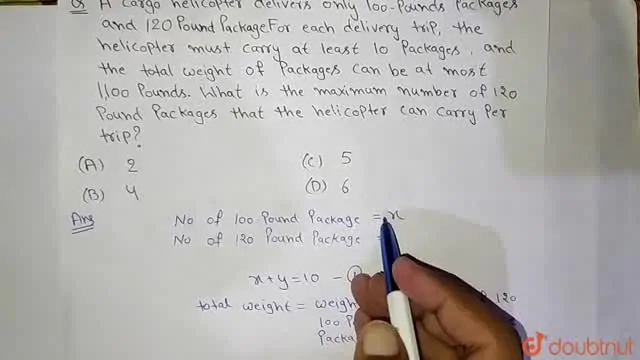A cargo helicopter delivers only 100-pound packages and 120-pound packages. For each delivery trip, the helicopter must carry at least 10 packages, and the total weight of the packages can be at most 1,100 pounds. What is the maximum number of 120-pound packages that the helicopter can carry per trip?
2
4
5
6
The correct Answer is:C
Let a equal the number of 120-pound packages, and let b equal the number of 100-pound packages. It’s given that the total weight of the packages can be at most 1,100 pounds: the inequality 120a + 100b ≤ 1,100 represents this situation. It’s also given that the helicopter must carry at least 10 packages: the inequality a + b ≥ 10 represents this situation. Values of a and b that satisfy these two inequalities represent the allowable numbers of 120-pound packages and 100-pound packages the helicopter can transport. To maximize the number of 120-pound packages, a, in the helicopter, the number of 100-pound packages, b, in the helicopter needs to be minimized. Expressing b in terms of a in the second inequality yields b ≥ 10 − a, so the minimum value of b is equal to 10 − a. Substituting 10 − a for b in the first inequality results in 120a + 100(10 − a) ≤ 1,100. Using the distributive property to rewrite this inequality yields 120a + 1,000 − 100a ≤ 1,100, or 20a + 1,000 ≤ 1,100. Subtracting 1,000 from both sides of this inequality yields 20a ≤ 100. Dividing both sides of this inequality by 20 results in a ≤ 5. This means that the maximum number of 120-pound packages that the helicopter can carry per trip is 5.
Choices A, B, and D are incorrect and may result from incorrectly creating or solving the system of inequalities.
Similar Questions
What is the total cost of 2.5 pounds of bananas at $0.34 per pound and 2.5 pounds of tomatoes at $0.66 per pound?
01:51View SolutionIn what proportion must rice at $0.8 per pound be mixed with rice at $0.9 per pound so that the mixture cost $0.825 per pound?
06:15View Solutionसंकुल के एक उदाहरण दीजिये-
धनायन संकुल04:10View Solutionसंकुल के एक उदाहरण दीजिये-
ऋणायन संकुल।03:41View SolutionA helicopter is ascending vertically with a speed of 8.0ms−1. At a height of 12 m above the earth, a package is dropped from a window. How much time does it take for the package to reach the ground ?
02:59View SolutionA helicopter is ascending vertically with a speed of 8.0 ms^(-1) .At a height of 120 m above the earth ,a package is dropped from a window.How much time does it take for the package to reach the ground?
04:03View SolutionA helicopter is ascending vertically with a speed of 8.0ms−1. At a height of 12 m above the earth, a package is dropped from a window. How much time does it take for the package to reach the ground?
View SolutionA helicopter is ascending vertically with a speed of 8.0 ms^(-1) . At a height of 120m above the earth , a package is dropped from a window . How much time does it take for the package to reach the ground ?
View Solution


